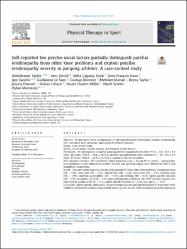| dc.contributor.author | Tayfur, Abdulhamit | |
| dc.contributor.author | Şendil, Ateş | |
| dc.contributor.author | Sezik, Atilla Çağatay | |
| dc.contributor.author | ... | |
| dc.contributor.author | Pawson, Jessica | |
| dc.contributor.author | Uzlaşır, Serkan | |
| dc.contributor.author | Miller, Stuart Charles | |
| dc.date.accessioned | 2025-04-10T11:34:38Z | |
| dc.date.available | 2025-04-10T11:34:38Z | |
| dc.date.issued | 2023 | en_US |
| dc.identifier.citation | Tayfur, A., Şendil, A., Sezik, A. Ç., Kaux, J. F., Sancho, I., Le Sant, G., ... & Morrissey, D. (2023). Self-reported bio-psycho-social factors partially distinguish patellar tendinopathy from other knee problems and explain patellar tendinopathy severity in jumping athletes: A case-control study. Physical Therapy in Sport, 61, 57-65. | en_US |
| dc.identifier.issn | 1466853X | |
| dc.identifier.uri | https://10.1016/j.ptsp.2023.02.009 | |
| dc.identifier.uri | https://hdl.handle.net/20.500.12513/7241 | |
| dc.description.abstract | Objective: To determine what combinations of self-reported factors distinguish patellar tendinopathy (PT) from other knee problems, and explain PT severity variance. Design: Case-control study. Setting: Social media, private practice and National Health Service. Participants: An international sample of jumping athletes diagnosed with either PT (n = 132; 30.7 ± 8.9 years; 80 males; VISA-P = 61.6 ± 16.0) or another musculoskeletal knee condition (n = 89; 31.8 ± 9.9 years; 47 males; VISA-P = 62.9 ± 21.2) by a clinician in the last 6 months. Main outcome measures: We considered clinical diagnosis (case = having PT vs control = having other knee problems) as the dependent variable. Severity and sporting impact were defined by VISA-P and availability, respectively. Results: A model comprising seven factors distinguished PT from other knee problems; training duration (OR = 1.10), sport type (OR = 2.31), injured side (OR = 2.28), pain onset (OR = 1.97), morning pain (OR = 1.89), condition acceptability (OR = 0.39) and swelling (OR = 0.37). Sports-specific function (OR = 1.02) and player level (OR = 4.11) explained sporting availability. 44% of PT severity variance was explained by quality of life (β = 0.32), sports-specific function (β = 0.38) and age (β = −0.17). Conclusion: Sports-specific, biomedical and psychological factors partially distinguish PT from other knee problems. Availability is mainly explained by sports-specific factors, while psychosocial factors impact on severity. Adding sports-specific and bio-psycho-social factors into assessments could help better identification and management of jumping athletes with PT. © 2023 The Authors | en_US |
| dc.language.iso | eng | en_US |
| dc.publisher | Churchill Livingstone | en_US |
| dc.relation.isversionof | 10.1016/j.ptsp.2023.02.009 | en_US |
| dc.rights | info:eu-repo/semantics/openAccess | en_US |
| dc.subject | Case-control study | en_US |
| dc.subject | Jumping Athletes | en_US |
| dc.subject | Outcome Predictors | en_US |
| dc.subject | Self-reported | en_US |
| dc.subject | Severity | en_US |
| dc.subject | Tendinopathy | en_US |
| dc.title | Self-Reported Bio-Psycho-Social Factors Partially Distinguish Patellar Tendinopathy From other Knee Problems and Explain Patellar Tendinopathy Severity in Jumping Athletes: A Case-Control Study | en_US |
| dc.type | article | en_US |
| dc.relation.journal | Physical Therapy in Sport | en_US |
| dc.contributor.department | Fizik Tedavi ve Rehabilitasyon Yüksekokulu | en_US |
| dc.contributor.authorID | Abdulhamit Tayfur / 0000-0001-7366-5212 | en_US |
| dc.identifier.volume | 61 | en_US |
| dc.identifier.startpage | 57 | en_US |
| dc.identifier.endpage | 65 | en_US |
| dc.relation.publicationcategory | Makale - Uluslararası Hakemli Dergi - Kurum Öğretim Elemanı | en_US |


















